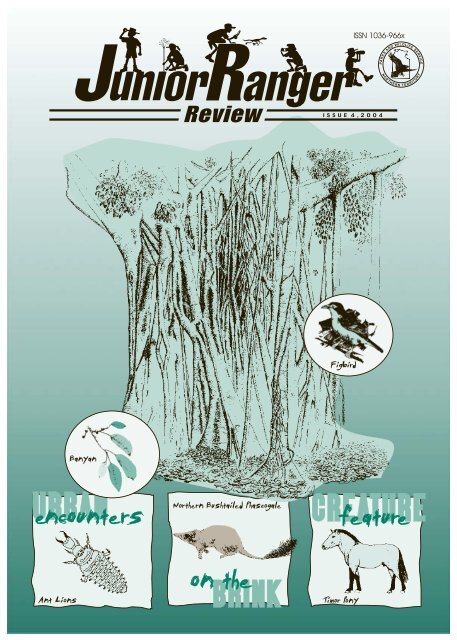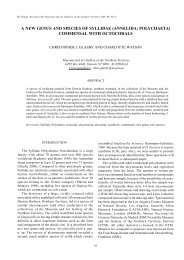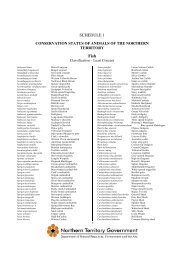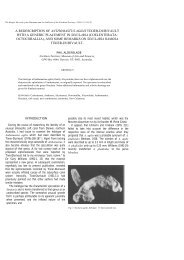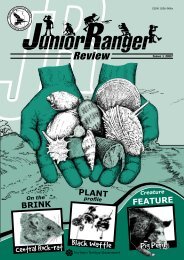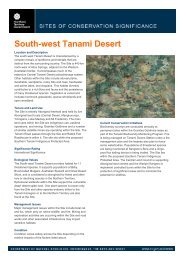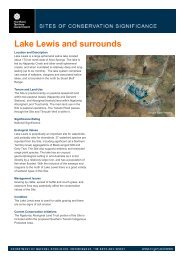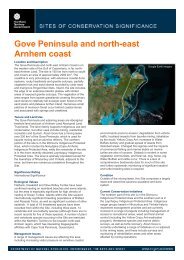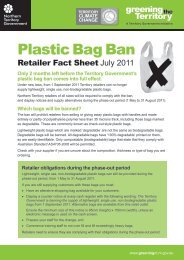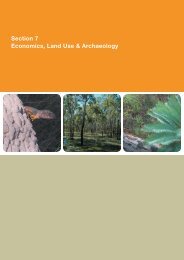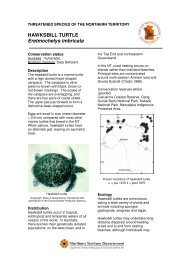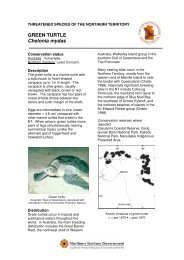rr04_4.pdf
rr04_4.pdf
rr04_4.pdf
You also want an ePaper? Increase the reach of your titles
YUMPU automatically turns print PDFs into web optimized ePapers that Google loves.
URBAN<br />
encounters<br />
Ant Lions<br />
Banyan<br />
Northern Bushtailed Phascogale<br />
on<br />
BRINK<br />
the<br />
ISSN 1036-966x<br />
ISSUE 4,2004<br />
Figbird<br />
PARKS AND WILDLIFE SERVICE<br />
N O R T H E R N<br />
T E R RIT O RY<br />
CREATURE<br />
feature<br />
Timor Pony
2<br />
CREATURE<br />
Timor Pony<br />
feature<br />
A small herd of Timor Ponies, Equus caballus lives on Cobourg Peninsula. The Timor Pony has<br />
survived there for over 170 years. This small group of animals may now have some historical<br />
significance as a relatively ‘pure’ race of ancient wild horse. Their long term fate is uncertain, as<br />
the area is a National Park called ‘Garig Gunak Barlu National Park’, where non-native animals<br />
are not traditionally tolerated. However, the Timor Pony is unlike the domestic horse that has<br />
gone wild or ‘feral’, breeding in large numbers and causing<br />
extensive damage to the land and bush ecology. Read on to<br />
Domestic Horse<br />
find out their amazing story.<br />
Timor ponies were shipped to the Coburg Peninsula in 1838 by<br />
the British when they attempted to create a settlement called<br />
Port Essington. The colony was abandoned in 1849. The British<br />
had hoped to create another Singapore, but were not prepared<br />
for the harsh climate and living conditions experienced on<br />
Australia’s northern coastline.<br />
When the British left Port Essington they abandoned all their<br />
livestock leaving it to run free. This included buffalos, pigs,<br />
Banteng cattle and Timor Ponies, all of which had been brought<br />
to Australia by ship.<br />
G'day from Ranger Bill<br />
Hi everyone. As the Junior Ranger programs<br />
across the Territory draw to a close for 2004 I<br />
would like to congratulate all staff involved in this<br />
popular Parks and Wildlife Service initiative. Many<br />
more young people have experienced the amazing<br />
beauty of our Parks and learnt about our flora<br />
and fauna. They have hopefully graduated from<br />
this program with a greater appreciation of the<br />
cultural and natural values of the Northern<br />
Territory. We thank everyone who contributed to<br />
the program, especially all the Junior Rangers<br />
and their parents for making 2004 a successful<br />
and enjoyable year.<br />
This also means that this is the last issue of the<br />
Junior Ranger Review for 2004. We hope you<br />
enjoyed the new look and revamped story content<br />
and look forward to bringing you many more<br />
interesting stories about our unique Territory<br />
wildlife next year. Have a great Xmas and holiday<br />
season!<br />
Ranger Bill<br />
Equus przewalksi<br />
These drawings show how much the domesticated<br />
horse has changed from the original ‘true’ wild horse<br />
Equus przewalksi.<br />
Very few of these animals exist,<br />
they are protected because they are similar to the<br />
modern horse’s wild ancestors.<br />
Famous ancestry<br />
The Timor Pony ancestry has been traced back to<br />
the thirteenth century AD. While the British<br />
relocated the ponies from Timor in the 1830s, they<br />
had originally arrived in Java in 1292, when Kublai<br />
Khan (a Mongolian emperor and explorer) sent two<br />
fleets of ships carrying Mongolian ponies to the<br />
southern seas.<br />
The Mongolian pony is now recognized as being<br />
closely related to the true ‘wild’ horse, which are not<br />
domesticated animals and have some distant<br />
resemblance to Zebras. They are recognised as the<br />
original horse. The domesticated horses family tree<br />
dates back 6000 years to the Asiatic wild horse of<br />
Mongolia, the Tarpan of eastern Europe and the<br />
more heavily-built Diluvial horse of northern Europe.
Have they changed the bush?<br />
It is currently believed that the Timor Pony has a<br />
minimal impact on the environment. They are very<br />
small and exist only in small numbers compared to<br />
pigs, buffalo and wild horses. These other animals are<br />
well known for causing extensive damage, due to their<br />
large size, existence in very large numbers and<br />
destructive habits. These animals also compete with<br />
the Timor pony for food.<br />
Fence them in?<br />
Prior to the time when Coburg Peninsula was made a<br />
National Park, a fence was placed across the ‘neck’ of<br />
the peninsula in order to contain the Timor Pony and<br />
the Banteng cattle. The fence line may have stopped<br />
the Timor Pony from spreading further and now their<br />
population is more controlled. Wild horses<br />
("brumbies") are not controlled, and their numbers<br />
have increased to many thousands causing extensive<br />
damage to the environment.<br />
Complete this puzzle to discover further<br />
facts about the Timor Pony.<br />
Timor Ponies were brought to Australia from______? ( 13 across)<br />
What do ponies eat? ( 3 down)<br />
In appearance, Timor Ponies are most similar to what type of animal? ( 12<br />
down)<br />
Timor Ponies are similar to the original wild horse, in that they have the<br />
following characteristics: Their coat is dun-coloured, they have thick<br />
necks, with heavy set___________ ( 7 across) . Their ________ ( 11 across)<br />
are set high up on their forehead, and are forward facing. Timor Ponies<br />
have thick, woolly manes, but their_________ (2 down) is not big at all.<br />
Timor Ponies have not been classified as feral animals, due to their low<br />
numbers. They are also being controlled by a_________ ( 9 across) which<br />
as been built across the narrow passage of the Peninsula to prevent them<br />
from spread ing.<br />
Nature also helps control their numbers.___________ ( 6 down) now eat<br />
them. Many Timor Ponies have scars from narrow escapes from attack.<br />
Over the last 170 years of their existence on the Cobourg Peninsula they<br />
are becoming part of the local _________________ ( 10 down) .<br />
Timor Ponies are descended from the famous__________ (4 down) Pony.<br />
Feral animals live alongside the Timor Pony. They are the______ (8<br />
across) and the_______ (1 across). These animals do a lot of damage to<br />
the bush. They cause soil _________ (11 down), and compete with our<br />
native animals for food.<br />
What is the name of a rare species of cattle that also live on Cobourg<br />
Peninsula? (5 down). They originally came from Bali in Indonesia.<br />
Cobourg Peninsula<br />
Northern<br />
Territory<br />
Natural control.<br />
The Saltwater (Estuarine) Crocodile, Crocodylus<br />
porosus ,<br />
often attacks and eats Timor Ponies.<br />
Many bear the scars from crocodile attacks.<br />
While it may seem cruel, crocodiles may be<br />
helping to maintain pony numbers, so they do<br />
not overpopulate the limited area of land in which<br />
they live.<br />
3<br />
1 2<br />
Dun coloured coat<br />
L<br />
K<br />
3<br />
Thick wooly mane<br />
7<br />
9 10<br />
4 5<br />
B D<br />
13<br />
11<br />
Short forlock<br />
High set eyes<br />
Thick neck<br />
Did you know?<br />
Why are wild horses in<br />
Australia called ”Brumbies”?<br />
Australias brumbies are not a true wild<br />
horse. They are descendents of<br />
domestic horses that went feral. A<br />
Private working for the NSW Army<br />
Corps named John Brumby went to<br />
Sydney in 1794. Whilst in the area he<br />
settled on a free land grant near<br />
Windsor. He used the land to breed<br />
horses. Later, in 1804, when he went<br />
to Tasmania the horses were left to<br />
run wild.<br />
In the years that followed, people<br />
referred to them as Brumby horses or<br />
simply brumbies.<br />
8<br />
6<br />
12
on the<br />
BRINK<br />
Northern Brush-tailed Phascogale<br />
The Northern Brush-tailed Phascogale Phascogale (taoatafa) is a small carnivorous marsupial. It<br />
spends most of its time up in trees (arboreal). We don't really know that much about this little<br />
animal although the way they live is likely to be similar to their southern cousins.<br />
4<br />
How will I know one if I see one?<br />
The most obvious feature is the long dark black bushy hairs on the tail that form a<br />
distinctive brush. When frightened these hairs can stand stiffly upright looking just like a<br />
'bottle-brush'. The rest of the body is coloured dark grey above and pale cream underneath.<br />
They have a pointy nose and large eyes and ears. It is smaller than a Northern Quoll, about<br />
the size of a large rat.<br />
It is an agile tree climber. The claws are long and sharp, the back feet have special climbing<br />
pads and it can turn its hind foot around 180 degrees at the ankle to help in climbing.<br />
Did you know?<br />
This Phascogale is still found in<br />
three NT reserves: Kakadu, Litchfield<br />
and Garig Gunak Barlu National Parks.<br />
DNA fingerprint evidence<br />
Recently scientists have been looking closely at the<br />
genetic fingerprints of phascogales. They have found<br />
evidence that there are probably three different<br />
species in Australia. The Northern Brush-tailed<br />
Phascogale is different to those found in southeastern<br />
and south-western Australia.<br />
Home sweet home<br />
Tall open Stringybark and Woolybutt eucalypt forests<br />
are the areas where these little creatures have been<br />
seen or caught. This habitat is important as it<br />
Northern Brush-tailed Phascogale<br />
Top End distribution<br />
provides them with the necessary tree hollows to<br />
rest in during the day.<br />
The Northern Brush-tailed Phascogale is most<br />
active at night (nocturnal) when it feeds in trees<br />
and on the ground. It will use its strong teeth<br />
and fingers to tear off bark and find prey<br />
underneath. They are also good for reaching for<br />
food in cracks and crevices. They love to eat<br />
cockroaches, beetles, centipedes, spiders and<br />
ants, but may include nectar and small birds and<br />
mammals in their diet.
Cute little babies<br />
During the mating season the female attracts males to her with a<br />
chirping sound. Mating usually takes place in the privacy of a tree<br />
hollow. After mating the male will wander off and often die alone! About<br />
30 days later three to eight babies are born in a nest made of bark,<br />
feathers and fur. She is a loving mother caring for her young until they are<br />
about twenty weeks old. They then leave home to look after themselves.<br />
Y ucky poo!<br />
Mother phascogales are not the most house<br />
proud of mums!<br />
Use the grid to find out why.<br />
D4 D5 A5 A1 C2<br />
B3 C5 C3 A5 D4<br />
To stop others from trying to their<br />
they piles of<br />
5<br />
Alarming and harming<br />
Phascogale numbers have dropped and we don't really know why. In fact we know very little at all about this<br />
creature. Down south they are disappearing mainly because we are clearing the bush to grow crops, and for<br />
timber and mining. In the north it is more likely to be because of changes in<br />
our bush caused by cattle and fire. Feral cats are also likely to be eating<br />
them. Given that this little animal is a predator there is also some<br />
concern that the arrival of the dreaded Cane Toad may further<br />
harm their chances of survival. More research must be done!<br />
Phascogale Fact File<br />
When scared this tiny animal begins<br />
to bang its front feet against the<br />
bark again and again.<br />
D4 D5 C5 D3 A5 D4 C3 A5 C2 C2 E5<br />
A2 C2 A1 A3 C1 D1 C5 C5<br />
in their<br />
A<br />
B<br />
C<br />
D<br />
E<br />
1 2 3 4 5<br />
A B C D E<br />
F G H I J<br />
K L M N O<br />
P Q R S T<br />
U V W X Y<br />
C4 A5 D4 D5 D4
URBAN<br />
encounters<br />
Backyard Predators - Ant Lions<br />
Imagine walking along in search of food and stumbling across a<br />
landscape that looks a bit like the moon with all its craters...<br />
Suddenly you fall into a cone shaped pit and sink towards a<br />
creature that looks like it belongs in a science fiction movie. You try to get out but the monster in<br />
the pit is flicking a shower of sand towards you which makes you slip further... Scary? Well yes if<br />
you're an ant!<br />
6<br />
A Lion in the sand?<br />
Ant Lions are the larvae of an insect called a Lace Wing. The Ant Lion has a flattened body and head (good for<br />
flicking sand), short legs (good for crawling backwards), and big jaws called mandibles (good for grabbing onto<br />
prey).<br />
Sinking into the jaws of death<br />
The Ant Lion digs a pit in the sand by spiraling backwards and then flicking out the sand<br />
with its head. Then it waits buried at the bottom of the pit for a small insect - most<br />
commonly an ant to come along and fall in. While the ant is struggling to get out the<br />
Ant Lion grabs the ant in its jaws, eats it like an ant smoothie and throws the body<br />
away like fast food packaging.<br />
Did you Know ?<br />
There<br />
are many<br />
different kinds of Lace<br />
Wings belonging to different<br />
families, but they are all part of<br />
the Order Neuroptera.<br />
Lace Wings<br />
Lace Wing<br />
A Lace Wing is an Ant Lion in adult form. The young Ant Lion goes through a<br />
complete metamorphosis, or body change and comes out with wings and things!<br />
The life of the Lace Wing is far shorter than its childhood stage and may only<br />
last for a couple of weeks. The Lace Wing is mainly active at night and its<br />
delicate transparent wings help keep perfect camouflage.<br />
The Lace Wing, that is a<br />
Meat or Vegies?<br />
grown up Ant Lion, is brown<br />
or grey and has short<br />
The Lace Wing is less fussy about its diet once it has grown up. Lace Wings<br />
antennae. are still predators of other insects such as aphids and scale insects, but may<br />
also eat sap, nectar and pollen.<br />
Look out for<br />
tracks and traces of Ant Lions in your<br />
backyard. You might even be lucky enough to see one having<br />
an ant snack or doing some pit renovations!<br />
A tell tale sign is the squiggly tracks that are left behind<br />
after finding a new home.<br />
Ant Lion
Take a closer look<br />
Try gently blowing on an Ant Lion pit with<br />
a straw to expose the large mandibles of<br />
this tiny predator.<br />
No food? No worries!<br />
Ant Lions can go for up to 2 or 3 months<br />
without having a meal! They don’t need to<br />
drink either because they get all their water<br />
from the food they eat. They conserve water in<br />
their bodies by moving around and building pits<br />
at night.<br />
Being hidden under the sand in the day is a<br />
good way to escape the harsh sunlight from<br />
drying their bodies out.<br />
C=<br />
A=<br />
Helpful hunters<br />
Lace Wings are used all around Australia by<br />
scientists and gardeners to control other insects<br />
that are sometimes considered to be pests.<br />
The Lace Wings eat plant pests such as aphids, sap<br />
suckers and scale insects that might damage<br />
commercial and garden plants.<br />
Using an insect such as a Lace Wing to control<br />
pests is called Biological Control.<br />
Family Portraits - Insect Predators<br />
What will the young insect be when it becomes and adult?<br />
Mosquito Wasp<br />
Beetle True Bug<br />
7<br />
E=<br />
B=<br />
D=<br />
Lace Wing
PLANT<br />
profile<br />
Fabulous NT Figs!<br />
Figs are a fascinating group of plants with over 1000 species<br />
throughout the world. Here in the Northern Territory we have<br />
about 25 of them. Read on and you’ll discover that there is more<br />
to a fig than meets the eye!<br />
8<br />
Ficus racemosa<br />
Have you seen the fancy fig flowers or tasted false fig fruit?<br />
Chances are that you have never noticed fig flowers, but you may have eaten them! That is because their flowers are<br />
actually inside the fruit. If you where to carefully cut open the fruit, you would see that it is actually a capsule full of<br />
tiny male and female flowers. So this ‘fruit’ is not a real fruit like an apple or orange; it is a false ‘fruit’!<br />
The inside story<br />
So if these flowers are hidden away inside the fruit, how do they get pollinated? It’s all done by tiny wasps,<br />
often no larger than a pinhead! And each different species of fig has its very own species of pollinating wasp.<br />
Did you know?<br />
At this time of year in the TopEnd, Figbirds,<br />
Sphecotheres viridis<br />
are gathering in large flocks<br />
to feast on the bounty of fruit that some ofour fig trees are producing. They use their beak to<br />
mash the larger figs into a sausage shape, then<br />
throwing their head back, they swallow it whole.<br />
1The<br />
pollen dusted female<br />
wasp finds an immature<br />
fruit. She pushes her<br />
way in, pollinating the<br />
female flowers that then<br />
develop into seeds. She<br />
then lays her eggs and<br />
dies within the fig<br />
4<br />
The tiny female<br />
wasps grow up and<br />
become dusted with<br />
pollen when they<br />
escape the fig by a<br />
tiny hole in the top.<br />
They then fly off to<br />
find an immature fig,<br />
starting the cycle<br />
again.<br />
2<br />
The wasp eggs hatch<br />
in the fig and the<br />
tiny larvae feed on<br />
infertile female<br />
flowers.<br />
3<br />
The wingless male<br />
wasps then mate<br />
with the females.<br />
After mating they<br />
die without ever<br />
seeing the outside<br />
world!
Fellowship of the Figs!<br />
The mighty Banyan- the Lord of the Figs<br />
Banyans, Ficus virens can start life in strange places. Birds, bats and possums<br />
often poo seeds on top of rocks, other tree branches, or even roofs. If it<br />
manages to grow it will send down aerial roots from its branches. Once these<br />
establish, they thicken up and become supports. Eventually they will join with<br />
the main trunk, often ‘strangling’ other plants or objects. Aboriginal people eat<br />
the fruit and use the bark from the aerial roots to make string.<br />
The rugged Rock Fig<br />
There are several species of Rock Fig in the Territory, and as the name suggests, they<br />
grow in amongst rocks! Even in dry central Australia, they find enough water deep in the<br />
rocky cliffs and gorges to show off their bright green, tropical looking leaves. Their fruits<br />
are important sources of food for both animals and humans. In parts of central Australia<br />
some<br />
very rare native snails are only found in the figs’ leaf litter.<br />
The rough and ready Sandpaper Fig<br />
There are two species of Sandpaper Fig in the Top End, Ficus opposita (pictured) and the<br />
similar Ficus scobina. Their rough abrasive leaves are their most obvious feature.<br />
Aboriginal people eat the fruits and use the other parts of the plant for bush medicines.<br />
These include treatments for colds, diarrhoea, eye problems, muscular aches, and sores.<br />
And of course the leaves make great sandpaper for sanding spears!<br />
The friendly fruit shop Fig<br />
The big edible fig that you buy at the shops is not a native. Its scientific name is Ficus carica<br />
and people have been growing them for around 5000 years! It is leaves from this plant that<br />
Adam and Eve used to cover their nakedness in the Biblical story of the Garden of Eden.<br />
Fruity Fact Finder<br />
Answer these questions to reveal the scientific name for a figs false fruit.<br />
1. The insect that pollinates a fig.<br />
2. The common name of Ficus virens.<br />
3. A type of mollusc that lives in the leaf litter of Rock<br />
Figs in central Australia.<br />
4. The scientific name of the edible fig you buy at the<br />
shops is Ficus______? 5. Banyantreesdeveloplargeaerial_____ thathelp<br />
support the tree.<br />
6. Female wasps get dusted in this as they leave the<br />
fig in search of a new immature fruit.<br />
7. These feathered animals often eat figs and help<br />
spread the seeds.<br />
8. All figs are in this genus.<br />
9. Which sex of wasp dies in the fig without ever seeing<br />
the outside world.<br />
9<br />
6<br />
P<br />
4<br />
2<br />
8<br />
1<br />
F I<br />
3<br />
5<br />
7<br />
9
NATURE<br />
Help protect habitat!<br />
There are 8 native animals living in this<br />
typical woodland scene (below). Find<br />
them in the picture and draw a line between<br />
their name and their habitat (home). One has<br />
already been done for you. Once you’re done,<br />
you could colour it in.<br />
Cockatoo<br />
Spider<br />
Carpet Python<br />
Quoll<br />
Echidna<br />
Northern<br />
Blossom-bat<br />
Sugar Glider<br />
Gecko<br />
quiz<br />
Rocks & logs<br />
Tree hollows<br />
Hollow logs<br />
Tree bark<br />
Tree hollows<br />
Rocks and logs<br />
Tree bark<br />
Hollow logs<br />
10<br />
Old trees and their hollows are<br />
important habitat for many animals.<br />
Join the dots to discover what lives in<br />
this one, and then colour it in.<br />
23<br />
22 29<br />
1<br />
68<br />
67<br />
66<br />
65<br />
2 7<br />
3 6<br />
4<br />
5<br />
20<br />
31<br />
34<br />
32<br />
33<br />
35<br />
64<br />
61<br />
63 62<br />
60<br />
55<br />
56<br />
59 54<br />
42<br />
47<br />
48 43<br />
46 41<br />
49 44<br />
45<br />
40<br />
50 39<br />
36<br />
37<br />
38<br />
58<br />
57 53<br />
52<br />
51<br />
8<br />
9 14<br />
10<br />
13<br />
11<br />
12<br />
15 16 17<br />
18<br />
19<br />
21<br />
24<br />
28<br />
30<br />
25<br />
27 26<br />
Puzzles adapted from Hands<br />
on for Habitat<br />
by DEH.
11<br />
PROJECT<br />
page<br />
Green kids can make a difference!<br />
There is widespread community concern about environmental issues. Over the year you have read<br />
about several threatened species and the problems they face. But don t despair! Here are 6<br />
simple things that you can do to help the environment.<br />
1<br />
Reduce,<br />
reuse and recycle! Try to<br />
reduce the amount of plastics that<br />
you buy. Reuse things when you can (for<br />
example, reuse plastic drink bottles). And<br />
recycle things like glass, aluminium and<br />
paper.<br />
3Be<br />
water and energy wise. Turn<br />
off the tap when you are brushing<br />
your teeth, as every drop is precious.<br />
And turn off the lights when you are<br />
not using them!<br />
4<br />
Make compost.<br />
Refer to issue 2 on how<br />
to make your own worm<br />
composter, or simply make a<br />
compost pile out of food scraps.<br />
This will be great for your<br />
garden and reduce landfill.<br />
6 Be<br />
a responsible fisherman. Throw back fish that<br />
are too small. Be careful not to lose your nets, lines,<br />
hooks, and sinkers in the water. All sorts of animals<br />
can get caught in these.<br />
2 Ask your parents<br />
if you can plant local native<br />
trees instead of non-native ones in<br />
your garden. This will not only provide food<br />
and shelter for native animals, but it will help<br />
stop introduced garden plants spreading into<br />
the bush and becoming weeds.<br />
5<br />
Keep your cat and dog under<br />
control. Did you know that the<br />
average family cat kills 8 birds, 16<br />
mammals and 8 reptiles each<br />
year? Keeping them in at night will<br />
help. And dogs can kill or stress<br />
native animals, so when you go out<br />
bush, leave them at home.
DISCOVER<br />
a territory park<br />
The Larapinta Trail<br />
Where is it?<br />
The Larapinta Trail is an exciting long distance walking track through the<br />
spectacular West MacDonnell and Chewings Ranges in Central Australia.<br />
The trail starts at the Alice Springs Telegraph Station and finishes<br />
approximately 250km West at Mt Sonder.<br />
The walk is made up of 12 sections with varying degrees of difficulty.<br />
When is the best time to<br />
walk?<br />
It is strongly advised that the<br />
walk should only be attempted<br />
between April and October.<br />
Outside these dates<br />
temperatures in Central<br />
Australia are very high. Walking<br />
in these warmer months should<br />
only be done in early mornings<br />
or late afternoons.<br />
Do I need to be an<br />
experienced bushwalker?<br />
The walk is intended to appeal<br />
to ‘trekkers’ - people who are<br />
not necessarily wilderness or<br />
map and compass bushwalkers,<br />
but are still capable walkers<br />
that are prepared to carry<br />
reasonable loads and camp out.<br />
Some sections are designed to<br />
cater for people with less<br />
bushwalking experience and have<br />
additional facilities.<br />
How long does it take?<br />
To walk the whole trail you’ll<br />
need about two weeks. However,<br />
walkers can join or leave the<br />
trail at a number of 2 or 4WD<br />
The Junior Ranger Review is published four times a year<br />
by the Parks and Wildlife Service of the Northern Territory.<br />
This edition was written by Dean McAdam, Andrew<br />
Pickering, Dave Rochford and Kylie Green . Design and<br />
layout by Nanet Pagsanjan. The front cover by A.<br />
Pickering. Illustrations by A. Dunlop, A. Pickering, A.<br />
Taylor, K. Kessing, M. Andrews, K. Kerr, B. Whiteford and<br />
D. McAdam.<br />
vehicle access points. Each<br />
section is usually a one or two<br />
day walk.<br />
What’s the attraction?<br />
Walkers from all over Australia<br />
and the world are coming to<br />
Alice Springs to walk the<br />
Larapinta Trail. Aside from the<br />
rewarding and at times<br />
challenging walk experience, the<br />
scenery is unique and absolutely<br />
breathtaking.<br />
The walk is set in the diverse,<br />
rugged landscape of the West<br />
Contributions & subscription<br />
requests are welcome and<br />
should be sent to:<br />
The Editor,<br />
Junior Ranger Review<br />
Po Box 496<br />
Palmerston NT 0831<br />
The trail is<br />
signposted<br />
with direction<br />
markers<br />
For more info on the trail, maps and the Walker<br />
Registration Scheme ph: (08) 8951 8250 or go<br />
to: www.nt.gov.au/ipe/pwcnt<br />
Puzzle Answers<br />
Plant Profile:<br />
Wasp, Banyan, snail, carica,<br />
roots, pollen,<br />
birds, Ficus,<br />
male - Synconium.<br />
Urban Encounter:<br />
A - Beetle, B - Lace wing, C - Mosquito, D -<br />
Wasp, E - True Bug.<br />
Creature Feature:<br />
Across: 1 - buffalo, 7 - bodies, 8 - pig, 9 -<br />
fence, 11 - eyes, 13 - Timor. Down: 2 -<br />
forlock, 3 - grass, 4 - Mongolian, 5 -<br />
Banteng, 6 - crocodiles, 10 - ecology, 11 -<br />
erosion, 12 - horse.<br />
On the Brink:<br />
To stop others from trying to steal their<br />
homes they store piles of smelly black poo<br />
in their nests.<br />
MacDonnell National Park and<br />
scenery ranges from mountain<br />
peaks to gorges & dry river<br />
valleys.<br />
Keep your eye out for the beautiful plants<br />
& animals that call the Ranges home.<br />
Mt Sonder<br />
Please note: You are welcome to photocopy the text &<br />
illustrations in this book without prior permission for nonprofit<br />
educational purposes only. If text is reproduced<br />
separately it must not be altered and Parks & Wildlife<br />
Service of the NT must be acknowledged as the source.<br />
(If you wish to use the illustrations, permission must be<br />
sought). Please contact the editor if in doubt.


